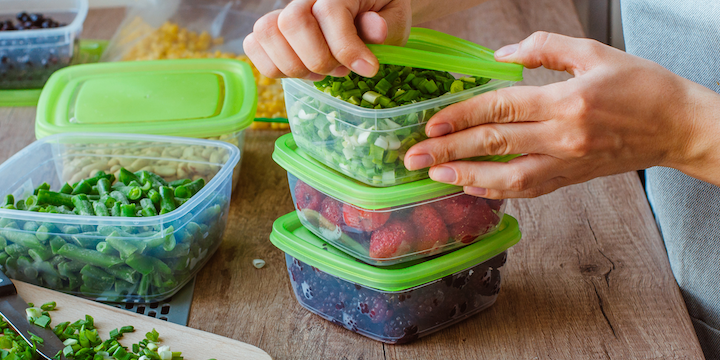
We know that making healthy meals requires using good-for-you ingredients. But did you know that good cooking methods play a key part too because they help foods retain more of their vitamins and nutrients? Here are some diabetes-friendly cooking methods to help boost the health factor on your next meal, as well as some pros and cons for each so you can decide what method is best for you.
Steaming: This cooking method requires moist heat. Food is covered in a pot over boiling water, which helps it to retain more of its shape and texture. Steaming is a good option for cruciferous vegetables (e.g., broccoli, Brussel sprouts etc.) as well as fish (e.g., salmon, trout, tilapia etc.) and dumplings.
Pros: Steaming is one of the best cooking methods for preserving nutrients in foods. In fact, research shows that steaming vegetables (i.e., carrots, cabbage and peppers) can provide more antioxidants than eating these same foods raw.
Cons: After steaming, foods may lack flavour, get soggy and require additional seasoning. Steaming also takes longer than methods like direct boiling or stir frying.
Roasting & Baking: As both these forms of cooking use dry heat, they often don’t require additional fats such as oil. Roasting is generally used for vegetables and proteins, while baking is reserved for bread, muffins etc.
Pros: Roasted and baked foods tend to have a richer taste and texture and retain more nutrients than other cooking methods.
Cons: Both can be time-consuming and can require your oven to be on for long periods of time. There is also a significant decline in B vitamins in roasted meats due to long cooking times at high temperatures.
Grilling & Broiling: Both are dry heat, high-temperature cooking methods. When grilling, the heat source is below the food, while broiling involves a heat source from above.
Pros: Food can be quickly broiled or grilled quickly to doneness. Grilling outside also helps keep house temperatures cooler in the summer.
Cons: Up to 40% of B vitamins and minerals can be lost when nutrient-rich juices drip away from meat. There are also issues around polycyclic aromatic hydrocarbons (PAHs), which are potentially cancer-causing substances, so far in animal studies only, formed when meat is grilled and fat drips onto a hot surface. Fortunately, there are things you can do to reduce these drippings such as trimming off excess fat, removing skin, and using acidic marinades (with lemon or vinegar). Grilling and broiling also promotes the formation of advanced glycation end products (AGEs), which are linked to heart and kidney diseases, as well as skin aging. Removing meat from high heat before it gets charred can reduce the number of AGEs produced.
Here’s a tasty recipe for grilled peach salad.
Stir frying: This cooking method involves sautéing foods in small amounts of oil over high heat. Unlike deep-frying, stir frying requires far less fat and generally is a healthy way to prepare foods.
Pros: Cooking for a short time without water prevent the loss of B vitamins, while the fat improves the absorption of antioxidants and plant compounds.
Cons: Research has shown that stir frying significantly reduces the amount of vitamin C in foods like broccoli and cabbage.
Here’s a recipe for Honey Garlic Chicken Stir Fry.
Poaching: This involves submerging food in water, milk or stock to cook. It requires heating the desired liquid to a temperature of about 180F (82C), which is lower than simmering and boiling. Since poaching is done at a lower temperature, it is best for delicate proteins such as eggs, chicken and fish.
Pros: Poaching keeps food juicier and prevents proteins from getting too tough.
Cons: It’s not suitable for large or tougher pieces of protein and there is some nutrient loss from the food into the cooking liquid. If possible, be sure to consume the cooking liquid as well.
Air frying: Similar to a convection oven, a fan circulates hot air around food in an air-fryer. The circulating air cooks the outside of the food first making it crispy, while keeping the inside soft to resemble the texture and taste of deep-fried foods. This is a healthier alternative to frying because it uses little to zero oils and cuts down on calories.
Pros: Air frying cooks foods quickly, with little fat.
Cons: Some meats, cheeses and fish become less nutritious with air frying because of AGEs. The unit has limited capacity, takes up counter space and can be costly to purchase.
Read more about how air fryers fit into a diabetes diet.
Microwaving: Quick, convenient and safe, microwaving is another cooking option that preserves the nutrients of foods due to short cook times.
Pros: It’s quick, easy and especially ideal for reheating leftovers. It also does a good job of preserving a food’s vitamin C and other nutrient content.
Cons: With limited capacity, microwaving is not practical for larger meals. This cooking method can also dehydrate food and change its texture. Like an air fryer, it can take up significant counter space and be costly to purchase.
Next time you’re tempted go for a deep-fried meal option, remember that there are many diabetes-friendly cooking methods that are better choices for your health. While there is no cooking method that retains all of a food’s nutrients, cooking for shorter periods at lower temperatures, and with less water, will have the best results.
Here are more tips on healthy meal preparation.


